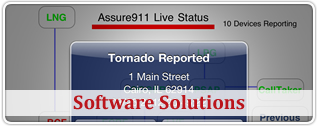Archive for the ‘NG911’ Category
Monday, May 18th, 2015
Almost all providers of software in the NG9-1-1 industry, while committed to interoperability and adherence to standards, are in the end only responsible for and therefore dedicated to the quality of their own products and services. The 9-1-1 ecosystem is broader than the NG9-1-1 core and PSAP premises components. The firms who are 9-1-1 SSPs for NG 911 deployments, have realized the need to monitor all components of the multi-vendor platforms that they place onto the ESInet, and encouragingly in some cases, the ESInet itself is included in that monitoring. However, the ecosystem, both in the case of legacy E9-1-1 and Next Generation 9-1-1, is broader. It includes equipment, software and the underlying network transport, power and other services that support all phases of 9-1-1 call management, from call origination, to database service providers, and on to the PSAPs for dispatch to the First Responders.
The evolving NG 9-1-1 industry has challenges and opportunities with Reliability and Quality of Service. Parties who share in the end to end network service quality can benefit from real time information sharing between parties on a limited basis. The FCC sees this as a critical area to which attention must be given. At recent IEEE CQR Workshop in Charleston, S.C., Admiral David Simpson mentioned this in his keynote speech as prominently as the need to improve indoor location accuracy. Vendors and Systems Integrators in this space were asked to accept this challenge. At Assure911, that is the focus of our work.
There are specific trends that are interrelated here – on one hand, primary 9-1-1 SSPs are looking to reduce costs. Traditional large carriers 9-1-1 SSPs are transitioning to the role of subcontractor, providing underlying network infrastructure and in some cases looking to reduce their 9-1-1 SSP roles. New 9-1-1 service providers intent on supplying outsourced services as well as those providers intent on taking over the role of primary must succeed in maintaining not only the reality of reliability, but the perception as well. The progress of the national roll out of Next Generation 9-1-1 depends on their success.
An impressive definition of the perception of reliability was expressed by a town manager who said that people in his jurisdiction, upon encountering someone bleeding, would take the time to dial 9-1-1 first, and only attend to the injured person after that. The expectation of success in obtaining necessary assistance in a rapid manner is so high that people don’t hesitate to leave someone to bleed a few more moments while investing the time to make the call. That is a perception that might be hard to match, but it should be the goal. It is the bar set by the success of the existing legacy infrastructure and the ability of the 9-1-1 SSP in that area to operate it reliably.
We look forward to helping the 9-1-1 industry achieve such a high level of reliability in both perception and reality.
Posted in FCC, NG911 | No Comments »
Tuesday, February 3rd, 2015
The FCC has released a Notice of Proposed Rulemaking (NPRM) in which they discuss the architecture and ownership of our nation’s 9-1-1 services. With the increasingly shared responsibility for the path between callers and the PSAP the FCC expresses concern that recent server outages are due to a lack of collaboration and missed opportunities to share information. The fear is that their advocacy for reliable 9-1-1 service nationwide is not being taken seriously.
The document, FCC 14-186, gives the strongest arguments for real-time monitoring of the end-to-end network path that has ever been expressed by the commission.
“Our goal of proactive, measured accountability for reliable 911 call completion extends from the provision of service to the 911 caller at one end to the provision of service to the PSAP on the other.” FCC 14-186A1, Paragraph 7, Page 4
Since we at Assure911.net, LLC have been speaking publicly about this very topic from the time of our launch as a start-up several years ago, we could not be more gratified that the commission has adopted precisely the type of policy that we have always believed was needed to get the industry to the level of reliability that we know can be achieved. Our partners have been speaking on this topic and developing solutions in this space even before we formed ourselves as an a start-up LLC.
Several of my earlier blog posts provide our opinion on this topic. Many of the presentations available on this website have detail that explains what setting up end-to-end monitoring means to service providers. My most recent presentation can be viewed here.
We will be providing comments on this NPRM, as we have done in the past, and please don’t hesitate to contact us if you would like to talk about something so near and dear to our hearts.
Posted in FCC, NG911 | No Comments »
Thursday, May 30th, 2013
Start with a vision for the future. Add some good old fashion teamwork and sprinkle with can-do attitude. Don’t ever take “No” for an answer. If you can do that, then you’ll know how Assure911’s friend and client, Ken Smith and his neighbors are leading the way to the future of emergency communications. Ken is Williamson County, Illinois’ 9-1-1 coordinator, and a board member of The Counties of Southern Illinois, a group that we have discussed many times during the past few years, on this website and at conferences around the country.
Read a great interview in Urgent Communications where Ken describes how rural communities that work together can be a beacon to the rest of the nation.
The full interview can be viewed here:
Rural Illinois counties light the path to NG-911
Posted in NG911 | Comments Off on Next Generation 9-1-1 is a Team Effort
Friday, March 29th, 2013
The FCC has acted on the subject of 9-1-1 Reliability. On March 20, 2013 the commission issued a document describing key areas where the Public Safety infrastructure can be improved in the area of reliability.
To view the document: http://www.fcc.gov/document/improving-9-1-1-reliability
At Assure911 this topic is very dear to our heart. In fact it is the very reason for our existence. Our mission is to make sure that emerging 9-1-1 services are as reliable as possible. In order to back up our belief that we can positively impact developments in this area, we have placed our experience, energy, intellectual property (software, trademark, patents), daily efforts, and a great deal of our own money into ensuring that the industry gets our message.
We are very gratified that the FCC agrees!
One of the items discussed in the FCC’s document is improved outage notification to PSAPs. Our patented Assure911 system that solves that very problem, using a smart-phone App.
We have traveled around the country speaking about how 9-1-1 networks must be managed for highest reliability.
It is now our great honor to be able to provide comments on the document, which we have already begun working on.
Here are a few of the presentations that we’ve made where reliability has been discussed:
In the fall of 2011, at IIT’s Real Time and 9-1-1 Conference:
NG 9-1-1: Reliability After Design – Design and Reliability Solutions for Emergency Services Networks
At the IPSTA Conference in Springfield Illinois in the summer of 2012:
Next Generation 9-1-1 Texting, Video Calling, and Network Management
Most, recently at the APCO Emerging Technology Forum in Anaheim, January 30, 2013:
Assure911® Reliable Operations for Public Safety Communications
Posted in FCC, NG911 | Comments Off on FCC Proposes to Improve 9-1-1 Reliability
Tuesday, March 26th, 2013
David Staub, Managing Partner of Assure911.net, spoke at the APCO Technology Forum on January 31, 2013 as a member of a panel of App Developers that have created innovative software supporting public safety. The Assure911 system was discussed for its ability to help public safety communications managers sort through the vast amount of data available about the health and performance of their infrastructures. For example, when a citizen attempts to reach 9-1-1 and cannot get through, the Assure911 Mobile App alerts the appropriate people in the public safety organization who can respond to the caller as well as begin to correct the problem.
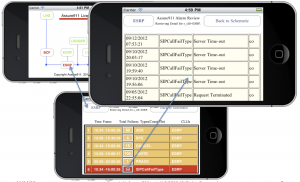 Handling Call Failures in Next Generation 9-1-1
A demo was given to show how incoming text messages can be analyzed for context and alerts sent to public safety officials. Twenty-one audience members downloaded the Assure911 Demo App from Google Play playing the role of a Police Chief or other First Responder. The remaining audience members were invited to sent text messages to Assure911’s test facility which emulates a Next Generation 9-1-1 System, including NG 9-1-1 PSAPs. Half of the room sent random text messages, while the other half reported a serious event. The data was processed and those with the Mobile App were alerted to the event in progress in with on-screen alerts as shown below.
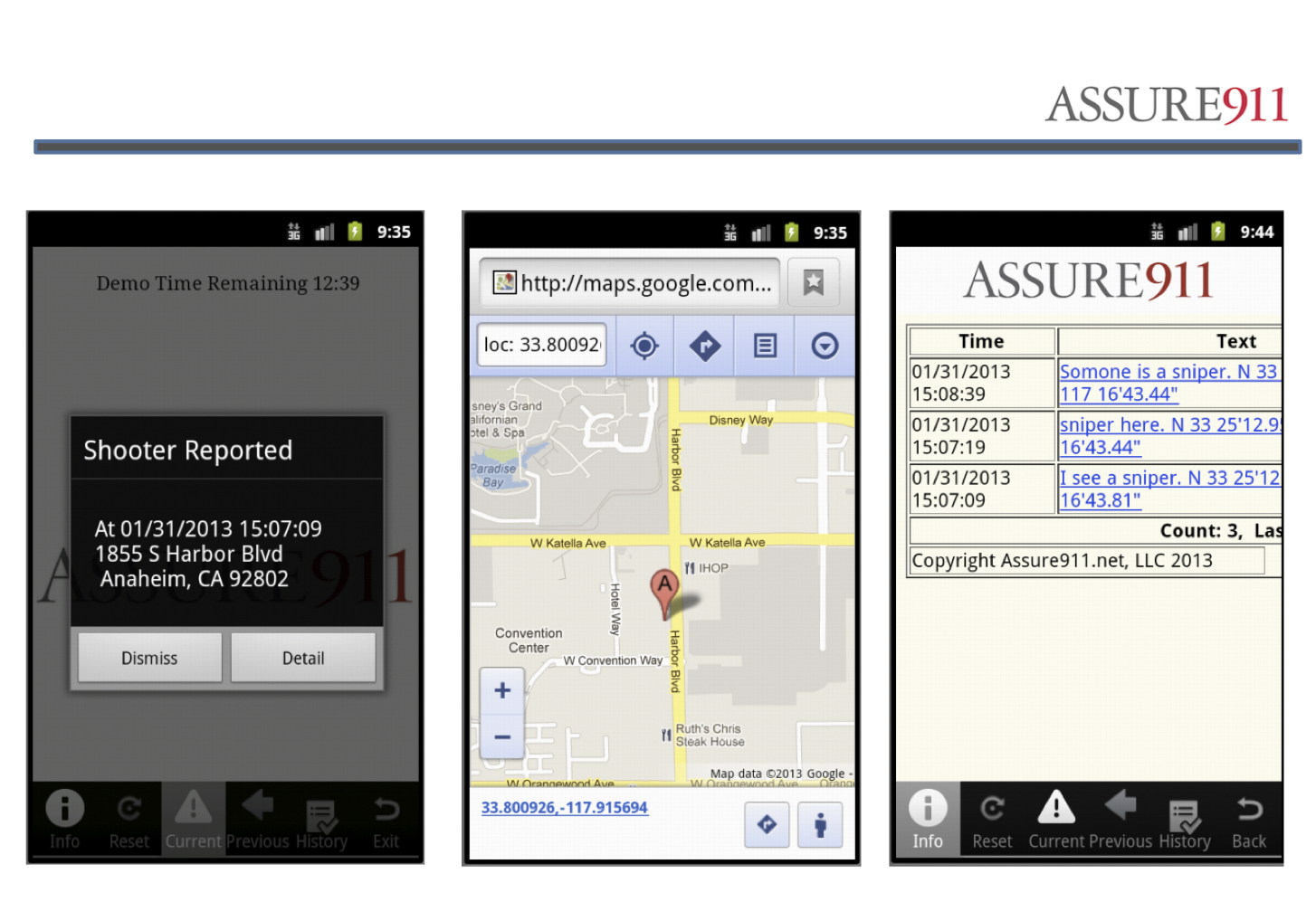 Secure Text Analysis and Alerting
The presentation can be downloaded from the APCO website here:
APCO Winter Technology Forum 2013 – Innovating New Tools and Apps for First Responders
Posted in Conferences, Mobile Apps, NG911, Uncategorized | Comments Off on Reliable Communications discussed at APCO Emerging Technology Forum
Thursday, October 25th, 2012
How will texts and video calls be handled by the PSAP in the near future?
Demonstrations of these capabilities were given at the Illinois Public Safety Telecommunications Association (IPSTA) 2012 conference earlier this week (October 21 – 24, 2012) in Springfield, Illinois. The presentation by the team of Barbara Kemp and David Staub of Assure911 and Brian Knueppel of Acme Packet showed how text messages and video calls can be routed by location of the caller to a call taker at the appropriate PSAP. The connections leveraged the ESInet and NG 9-1-1 system set up in the Real Time Communications Lab at the Illinois Institute of Technology (IIT), to deliver text messages from a handheld device in the auditorium to a laptop registered as a call taker on the i3 PSAP located at the Lab.
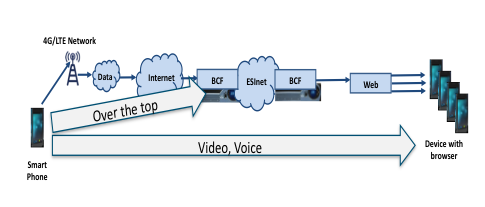 Secure Video with Broadcast The video call showed the ability to provide important visual data, in this case the building floor plan, from the scene of a simulated emergency event to the call taker position.
Barbara Kemp outlined the way a call flows through an NG 9-1-1 system. A write-up on the subject in everyday terminology can be downloaded by clicking below:
NG 9-1-1 Call Flow
Another demonstration showed how video from a caller can be distributed to a wider audience using existing video broadcasting technology. What made this and the other connections special, besides routing based on location, was that they were all completely secure. Since the flow of data went through the IIT RTCL ESInet, in each case it was protected by the Acme Packet Border Control Function (BCF), one of the NG 9-1-1 Functional Elements deployed at the lab.
The presentation can be downloaded from the Assure911 website here:
Assure911 and AcmePacket at IPSTA 2012
The talk also covered the topics of ESInet Security, NG 9-1-1 Reliability and end-to-end Network Management. The Assure911 team showed the use a Mobile App for network management.
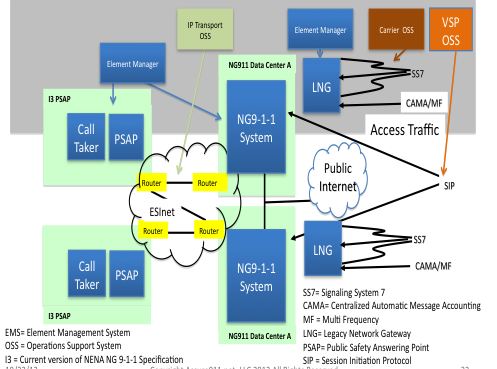 End to End Monitoring for Reliability
Posted in NG911, Uncategorized | Comments Off on Text, Video Calling, and Network Management demonstrated at IPSTA
Saturday, October 20th, 2012
Come see David Staub and Barbara Kemp of Assure911, and Brian Knueppel of ACME Packet at IPSTA this week. On Monday October 21, 1:30 PM, they will be speaking about Next Generation 9-1-1 Texting, Secure Video calls, and Network Management, in the “Plaza A” room. Demonstrations are planned and you can participate with the Assure911® Demo App.
An updated FREE APP for the Android platform is being made available to accompany Next Generation 9-1-1 Secure Text and Video calling demonstrations that are being given at The 28th Annual Illinois Public Safety Telecommunications Conference
October 21st – 24th, 2012, Crowne Plaza Hotel, Springfield, Illinois.
The Assure911.net and Acme Packet product teams are working together to highlight an important advancement in emergency communications made possible by NENA’s development of a set of standards for Next Generation 9-1-1.
The demonstrations will exhibit the ability to not only route text messages to the appropriate 9-1-1 call taker based on the caller’s geographic location, but also the ability of one of the NG9-1-1 functional elements (FEs), the Border Control Function (BCF), to monitor for important recurring themes in the body of the messages and alert the proper authorities. The cases of a campus bomb scare and a tornado sighting are to be demonstrated. The SMS messages are to be exchanged between an app on an Android-based smart-phone and an NG9-1-1 call taker. The position of the originator is obtained using the embedded GPS capability of their device. The BCF logs the event to the Assure911® Network Monitoring platform which in turn alerts a set of mobile devices in the audience, representing the smart-phones of NG9-1-1 system managers.
Demo Architecture Diagram
 Download the app now!!!
Complete instructions for the app are available here.
If you are attending the conference look for Assure911’s Barbara Kemp or Acme Packet’s Brian Knueppel for more information
Posted in Conferences, Mobile Apps, NG911, Uncategorized | Comments Off on Demo App for IPSTA 2012
Monday, June 11th, 2012
A new FREE APP for the Android platform is being made available to accompany Next Generation 9-1-1 Secure Text and Video calling demonstrations that are being given at the National Emergency Number Association (NENA®) Conference in Long Beach California between June 9th and 14th 2012.
The Assure911.net and Acme Packet product teams are working together to highlight an important advancement in emergency communications made possible by NENA’s development of a set of standards for Next Generation 9-1-1.
The demonstrations will exhibit the ability to not only route text messages to the appropriate 9-1-1 call taker based on the caller’s geographic location, but also the ability of one of the NG9-1-1 functional elements (FEs), the Border Control Function (BCF), to monitor for important recurring themes in the body of the messages and alert the proper authorities. The cases of a campus bomb scare and a tornado sighting are to be demonstrated. The SMS messages are to be exchanged between an app on an Adroid-based smart-phone and an NG9-1-1 call taker. The position of the originator is obtained using the embedded GPS capability of their device. The BCF logs the event to the Assure911® Network Monitoring platform which in turn alerts a set of mobile devices in the audience, representing the smart-phones of NG9-1-1 system managers.
Demo Architecture Diagram
 Download the app now!!!
Complete instructions for the app are available here.
If you are attending the conference look for Assure911’s Barbara Kemp or Acme Packet’s Brian Knueppel for more information
Posted in Conferences, Mobile Apps, NG911, Uncategorized, Website | Comments Off on App for Demos at NENA Conference
|
|
|
|










